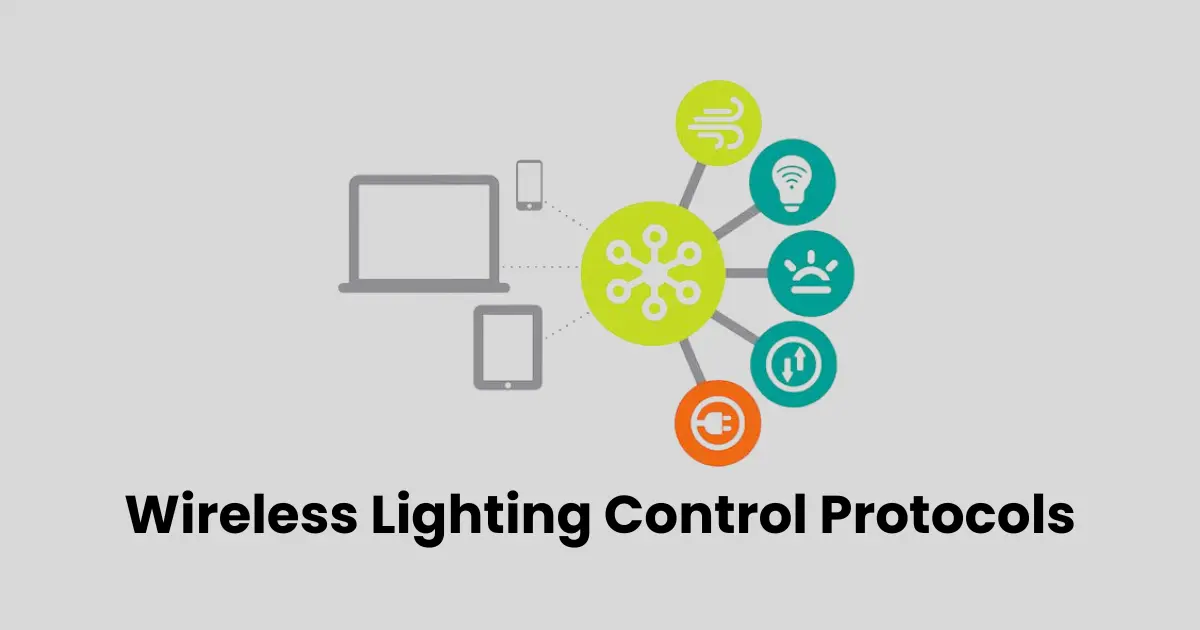Wireless Lighting Control Protocols: A Comprehensive Guide

Contents
- 1 What Are Wireless Lighting Control Protocols?
- 2 Benefits of Wireless Lighting Control Protocols
- 2.1 1. Easy Installation and Flexibility
- 2.2 2. Enhanced Energy Efficiency
- 2.3 3. Remote Access and Automation
- 2.4 4. Improved Security and Safety
- 2.5 5. Seamless Integration with Smart Home Systems
- 2.6 6. Scalability for Large Spaces
- 2.7 7. Reduced Maintenance Costs
- 2.8 8. Environmentally Friendly
- 2.9 9. Customization and Personalization
- 3 Types of Wireless Lighting Control Protocols
- 4 How Wireless Lighting Control Protocols Work
- 5 Key Features of Wireless Lighting Control Protocols
- 5.1 1. Wireless Communication
- 5.2 2. Mesh Networking for Extended Range
- 5.3 3. Remote Access and Cloud Integration
- 5.4 4. Energy Efficiency and Smart Scheduling
- 5.5 5. Low Power Consumption
- 5.6 6. Scalability and Easy Expansion
- 5.7 7. Secure and Encrypted Communication
- 5.8 8. Interoperability with Smart Home Ecosystems
- 5.9 9. Real-Time Monitoring and Diagnostics
- 5.10 10. Customization and Scene Settings
- 6 Choosing the Right Wireless Lighting Control Protocol
- 7 Future of Wireless Lighting Control Protocols
- 7.1 1. Increased Adoption of IoT and AI Integration
- 7.2 2. Expansion of Mesh Networking Technologies
- 7.3 3. Shift Toward Energy-Efficient and Sustainable Lighting
- 7.4 4. Standardization and Cross-Protocol Compatibility
- 7.5 5. Enhanced Security Measures
- 7.6 6. Widespread 5G and Edge Computing Integration
- 7.7 7. Smart Cities and Large-Scale Implementations
- 7.8 Conclusion
In today’s smart world, wireless lighting control protocols play a crucial role in managing and automating lighting systems efficiently. These protocols enable seamless communication between smart lights, sensors, and controllers, eliminating the need for traditional wiring. As a result, homeowners, businesses, and industries can experience improved energy efficiency, greater convenience, and enhanced security.
With the rise of IoT (Internet of Things), wireless lighting control protocols have become more advanced, offering features like remote access, dimming capabilities, and integration with voice assistants. Additionally, these protocols help reduce installation costs and make it easier to scale lighting systems in large spaces. Whether used in homes, offices, or commercial buildings, they provide a reliable and flexible way to control lighting without complex wiring.
In this article, we will explore wireless lighting control protocols, their benefits, popular types, working mechanisms, key features, and future advancements. By understanding these protocols, users can make informed decisions when selecting the best lighting control system for their needs.
What Are Wireless Lighting Control Protocols?
Wireless lighting control protocols are communication standards that enable smart lighting devices to connect and interact without physical wiring. These protocols facilitate seamless control of lighting systems using wireless signals such as radio frequency (RF), Bluetooth, or Wi-Fi. By leveraging these technologies, users can automate lighting settings, adjust brightness levels, and integrate lighting with other smart home or industrial systems.
Unlike traditional wired lighting systems, which require extensive cabling and manual operation, wireless lighting control protocols offer greater flexibility and ease of installation. They allow lighting devices, including smart bulbs, LED strips, and sensors, to communicate efficiently, creating an energy-efficient and customizable lighting environment.
These protocols are widely used in residential, commercial, and industrial settings. They support remote access, scheduling, occupancy detection, and even voice-controlled adjustments through smart assistants like Alexa, Google Assistant, and Siri. Moreover, they contribute to sustainability by optimizing energy consumption, reducing electricity waste, and improving user convenience.
As technology advances, wireless lighting control protocols continue to evolve, offering better security, improved interoperability, and enhanced automation capabilities. Understanding these protocols is essential for choosing the right lighting control system that meets specific needs and ensures long-term efficiency.
Benefits of Wireless Lighting Control Protocols
Implementing wireless lighting control protocols provides numerous advantages for residential, commercial, and industrial applications. These protocols not only improve lighting efficiency but also enhance convenience, security, and energy savings. Here are the key benefits:

1. Easy Installation and Flexibility
One of the biggest advantages of wireless lighting control protocols is their hassle-free installation. Since they eliminate the need for extensive wiring, setting up smart lighting systems becomes quicker and more cost-effective. Additionally, these systems can be easily reconfigured or expanded without modifying existing infrastructure.
2. Enhanced Energy Efficiency
Smart lighting systems powered by wireless lighting control protocols optimize energy consumption by enabling automation, dimming, and occupancy-based lighting. Features such as motion sensors and daylight harvesting ensure that lights operate only when needed, reducing unnecessary energy waste and lowering electricity bills.
3. Remote Access and Automation
With wireless lighting control protocols, users can control their lighting systems remotely through smartphones, tablets, or voice assistants. This feature allows homeowners and businesses to adjust lighting settings from anywhere, set schedules, and automate lighting based on occupancy or time of day.
4. Improved Security and Safety
Smart lighting can enhance security by integrating with other automation systems. For instance, outdoor lights can be programmed to turn on automatically at night or in response to motion detection. Additionally, remote access enables users to control lights while away, creating the illusion of occupancy and deterring intruders.
5. Seamless Integration with Smart Home Systems
Most wireless lighting control protocols are compatible with popular smart home ecosystems, including Amazon Alexa, Google Assistant, and Apple HomeKit. This integration allows users to create a fully connected environment where lighting, HVAC systems, and security devices work together for improved efficiency and convenience.
6. Scalability for Large Spaces
Wireless lighting control systems are highly scalable, making them ideal for large buildings, offices, and industrial facilities. Since no additional wiring is required, expanding the system is easy—new lights and sensors can be added and synchronized with minimal effort.
7. Reduced Maintenance Costs
Because wireless lighting control protocols allow for predictive maintenance and automated diagnostics, users can monitor system performance in real-time. This reduces maintenance costs by identifying potential issues early and minimizing downtime.
8. Environmentally Friendly
By optimizing energy usage and reducing reliance on traditional wiring, wireless lighting control systems contribute to sustainability efforts. These systems help lower carbon footprints by decreasing overall power consumption and extending the lifespan of lighting fixtures.
9. Customization and Personalization
With wireless protocols, users can create personalized lighting experiences based on preferences and specific needs. Smart lighting can adjust to different moods, activities, or events with customizable brightness, color temperature, and automation settings.
In summary, wireless lighting control protocols offer unparalleled convenience, efficiency, and security. As technology continues to advance, these systems will become even more intelligent, further enhancing user experience and energy savings.
Types of Wireless Lighting Control Protocols
Several wireless lighting control protocols are available today, each offering unique features, compatibility, and performance benefits. Choosing the right protocol depends on factors like range, energy efficiency, scalability, and integration with other smart devices. Below are the most commonly used wireless lighting control protocols:

1. Zigbee
Overview:
Zigbee is a low-power, mesh-based wireless lighting control protocol designed for smart home and industrial applications. It enables seamless communication between multiple devices while maintaining energy efficiency.
Key Features:
- Operates on the 2.4 GHz frequency band
- Supports mesh networking, ensuring extended range and reliability
- Low power consumption, making it ideal for battery-powered devices
- Compatible with smart home ecosystems like Amazon Alexa and Google Assistant
Best For:
- Smart homes and commercial buildings
- Large-scale lighting automation
- Environments requiring robust and scalable solutions
2. Z-Wave
Overview:
Z-Wave is another mesh-based wireless lighting control protocol known for its reliable and secure communication. Unlike Zigbee, Z-Wave operates on a lower frequency, reducing interference from Wi-Fi networks.
Key Features:
- Uses the sub-1 GHz frequency band for reduced signal interference
- Supports mesh networking for extended range and stable connections
- Strong encryption for enhanced security
- Works with smart home hubs like SmartThings and Home Assistant
Best For:
- Home automation with minimal interference
- Smart lighting control in multi-device environments
- Secure communication for IoT devices
3. Bluetooth Mesh
Overview:
Bluetooth Mesh is a newer wireless lighting control protocol that extends the capabilities of traditional Bluetooth by supporting large-scale, device-to-device communication. It is particularly useful for commercial lighting applications.
Key Features:
- Operates on the 2.4 GHz frequency band
- Creates a decentralized mesh network for large-scale control
- Lower energy consumption compared to Wi-Fi-based solutions
- Enables direct device communication without needing a hub
Best For:
- Office buildings and commercial spaces
- Smart lighting without requiring a dedicated hub
- Environments needing high device density
4. Wi-Fi
Overview:
Wi-Fi-based wireless lighting control protocols use existing Wi-Fi networks to connect smart lighting devices. These systems provide high-speed communication and seamless integration with cloud-based services.
Key Features:
- Operates on 2.4 GHz and 5 GHz frequency bands
- Offers high-speed data transmission for real-time control
- Direct internet connectivity without requiring additional hubs
- Compatible with mobile apps and voice assistants
Best For:
- Residential smart lighting systems
- Smart lighting setups requiring high bandwidth
- Users looking for direct cloud access and remote control
5. Thread
Overview:
Thread is an IP-based wireless lighting control protocol designed for secure, low-power, and scalable communication. It is particularly known for its interoperability and ability to integrate with existing smart home ecosystems.
Key Features:
- Uses the IEEE 802.15.4 standard for low-power, secure communication
- Mesh networking for better range and reliability
- Built-in security and end-to-end encryption
- Supports integration with Matter, the new universal smart home standard
Best For:
- Future-proof smart lighting systems
- Homes and businesses looking for a scalable, secure solution
- Environments needing high interoperability across different brands
Comparison of Wireless Lighting Control Protocols
| Protocol | Frequency Band | Network Type | Power Consumption | Best For |
| Zigbee | 2.4 GHz | Mesh | Low | Large-scale automation, commercial buildings |
| Z-Wave | Sub-1 GHz | Mesh | Low | Smart homes, secure IoT applications |
| Bluetooth Mesh | 2.4 GHz | Mesh | Medium | Office buildings, large-scale deployments |
| Wi-Fi | 2.4/5 GHz | Star | High | Home automation, cloud-based control |
| Thread | 2.4 GHz | Mesh | Low | Future-proof smart lighting, secure applications |
Each wireless lighting control protocol offers unique benefits depending on the use case. While Zigbee and Z-Wave provide strong mesh networking, Wi-Fi ensures fast, high-bandwidth communication. Meanwhile, Bluetooth Mesh and Thread offer scalable and secure solutions for modern lighting automation.
Understanding these options can help users select the best wireless lighting control protocol to optimize energy efficiency, connectivity, and overall performance.
How Wireless Lighting Control Protocols Work
Wireless lighting control protocols operate by establishing communication between lighting devices, sensors, and control systems using radio frequency (RF), Bluetooth, Wi-Fi, or other wireless technologies. These protocols enable real-time control, automation, and remote access to smart lighting systems without relying on traditional wired connections.

The working mechanism of wireless lighting control protocols involves several key components and steps:
1. Components of a Wireless Lighting Control System
A typical wireless lighting control protocol consists of the following elements:
- Smart Light Fixtures or Bulbs – These are LED bulbs or fixtures embedded with wireless receivers to receive control signals.
- Wireless Controller or Hub – Acts as a central unit that sends signals to connected lighting devices. Some protocols, like Wi-Fi and Bluetooth Mesh, can work without a hub.
- Sensors (Motion, Daylight, Occupancy) – Detect movement, ambient light levels, and occupancy to trigger automated lighting responses.
- User Interface (Mobile App, Voice Assistant, or Wall Switch) – Allows users to control lights manually or set automation schedules.
- Cloud or Local Processing – Some systems connect to the internet for cloud-based control, while others function locally for enhanced security and faster response times.
2. Communication and Data Transmission Process
Wireless lighting control protocols function through a step-by-step communication process:
Step 1: Sending a Command
The user initiates a command via a mobile app, voice assistant, or wall-mounted control panel. This command could involve turning lights on/off, adjusting brightness, or setting a timer.
Step 2: Signal Transmission
The control command is transmitted through the chosen wireless lighting control protocol (e.g., Zigbee, Z-Wave, Bluetooth Mesh, Wi-Fi, or Thread). The protocol ensures secure and interference-free signal transmission.
Step 3: Device Reception and Processing
The target lighting device receives the command through its embedded wireless module. Depending on the protocol used, the device may process the command locally or through a central hub before executing the action.
Step 4: Response and Feedback
Once the light executes the command, a status update is sent back to the controller or app. This allows users to verify actions such as brightness adjustments, color changes, or device status updates.
3. Network Topologies Used in Wireless Lighting Control
Different wireless lighting control protocols use distinct networking structures to transmit data efficiently:
- Mesh Networks (Zigbee, Z-Wave, Bluetooth Mesh, Thread)
- Devices act as both transmitters and receivers, extending signal range.
- If one device fails, others maintain communication, ensuring reliability.
- Ideal for large-scale lighting automation in offices, buildings, and smart cities.
- Star Networks (Wi-Fi, Traditional Bluetooth)
- A central hub or router connects all devices directly.
- Faster data transmission but requires a strong Wi-Fi connection.
- Suitable for home lighting systems with direct internet access.
- Hybrid Networks (Thread, Advanced IoT Systems)
- Combine mesh and star configurations for optimized performance.
- Provide low-latency, high-security connections with cloud-based integration.
4. Automation and Smart Integration
One of the biggest advantages of wireless lighting control protocols is their ability to automate lighting based on various conditions:
- Time-Based Scheduling – Lights turn on/off automatically at set times.
- Motion-Activated Lighting – Lights respond to movement in a room, conserving energy.
- Daylight Harvesting – Sensors adjust brightness based on natural light availability.
- Voice-Activated Control – Integration with Alexa, Google Assistant, or Siri enables hands-free operation.
- Scene Customization – Users can set personalized lighting scenes for different moods or activities.
5. Security and Encryption
As wireless lighting control protocols rely on data transmission, security is crucial to prevent unauthorized access. Most modern protocols use:
- AES-128 or AES-256 Encryption – Ensures secure communication between devices.
- Two-Factor Authentication (2FA) – Enhances security for remote access.
- Firmware Updates – Regular updates protect against vulnerabilities and cyber threats.
The working mechanism of wireless lighting control protocols involves seamless communication between smart lighting devices, sensors, and control systems. By using advanced networking topologies, automation features, and strong security measures, these protocols provide energy-efficient, flexible, and intelligent lighting control for homes, offices, and commercial spaces. As technology continues to evolve, wireless lighting solutions will become even more powerful, further enhancing efficiency and user experience.
Key Features of Wireless Lighting Control Protocols
Wireless lighting control protocols offer a wide range of features that enhance energy efficiency, automation, and user convenience. These protocols enable seamless communication between smart lighting devices, making them an essential part of modern home automation and commercial lighting systems. Below are the key features of wireless lighting control protocols:

1. Wireless Communication
Unlike traditional wired lighting systems, wireless lighting control protocols eliminate the need for complex wiring. They use radio frequency (RF), Bluetooth, Wi-Fi, or Zigbee to establish connections between controllers and light fixtures. This reduces installation costs and allows for flexible deployment.
2. Mesh Networking for Extended Range
Many wireless lighting control protocols, such as Zigbee, Z-Wave, Bluetooth Mesh, and Thread, utilize mesh networking. In a mesh network:
- Each device acts as a repeater, strengthening the signal.
- If one device fails, data is rerouted through other nodes, ensuring reliability.
- Large spaces, like offices and industrial buildings, benefit from extended coverage without additional hubs.
3. Remote Access and Cloud Integration
Smart lighting systems using wireless lighting control protocols can be controlled remotely via mobile apps or cloud-based platforms. Users can:
- Turn lights on or off from anywhere.
- Adjust brightness and color temperature.
- Monitor energy usage in real-time.
- Integrate with voice assistants like Alexa, Google Assistant, and Siri.
4. Energy Efficiency and Smart Scheduling
Energy conservation is a primary benefit of wireless lighting control protocols. These systems include:
- Dimming and Brightness Control – Adjust light levels to reduce power consumption.
- Motion Sensors – Turn lights on when motion is detected and off when the area is vacant.
- Daylight Harvesting – Automatically dim artificial lights when sufficient natural light is present.
- Time-Based Scheduling – Set lighting schedules to optimize energy use throughout the day.
5. Low Power Consumption
Most wireless lighting control protocols are designed to consume minimal energy. For instance:
- Zigbee and Thread use low-power IEEE 802.15.4 technology.
- Z-Wave operates at low radio frequencies, reducing battery drain.
- Bluetooth Low Energy (BLE) extends battery life for wireless switches and sensors.
These features make wireless lighting ideal for battery-powered devices and off-grid installations.
6. Scalability and Easy Expansion
As businesses or homeowners expand their lighting needs, wireless lighting control protocols allow for easy scaling:
- New devices can be added without rewiring.
- Mesh networks automatically recognize and integrate new devices.
- Large commercial spaces can use hybrid solutions combining multiple protocols.
7. Secure and Encrypted Communication
Security is crucial for smart lighting systems, and modern wireless lighting control protocols use:
- AES-128 or AES-256 encryption to protect data.
- Two-factor authentication (2FA) for secure remote access.
- Regular firmware updates to patch vulnerabilities.
These security measures prevent hacking attempts and unauthorized access.
8. Interoperability with Smart Home Ecosystems
Many wireless lighting control protocols are compatible with popular smart home systems, allowing seamless integration with:
- Amazon Alexa, Google Assistant, and Apple HomeKit for voice control.
- IFTTT (If This Then That) for automation with other smart devices.
- Smart thermostats, security cameras, and HVAC systems to create a unified automation experience.
This interoperability ensures that users can control multiple smart devices from a single platform.
9. Real-Time Monitoring and Diagnostics
Advanced wireless lighting control protocols offer real-time monitoring features, allowing users to:
- Track power consumption and optimize efficiency.
- Receive alerts for bulb failures or connectivity issues.
- Schedule predictive maintenance to extend device lifespan.
10. Customization and Scene Settings
With wireless control, users can personalize lighting based on their preferences. Features include:
- Scene Presets – Customize lighting for activities such as reading, working, or relaxing.
- Color Temperature Adjustment – Change from warm to cool lighting depending on the time of day.
- Group Control – Manage multiple lights simultaneously to create dynamic lighting effects.
The key features of wireless lighting control protocols provide flexibility, efficiency, and convenience for both residential and commercial applications. With benefits like energy savings, remote access, scalability, and enhanced security, these protocols are revolutionizing the way we control and interact with lighting systems. As technology advances, wireless lighting solutions will continue to improve, offering even more intelligent and eco-friendly solutions.
Choosing the Right Wireless Lighting Control Protocol
Selecting the best wireless lighting control protocol depends on various factors, including range, power efficiency, compatibility, security, and scalability. With multiple protocols available, understanding their strengths and limitations helps in making an informed decision.

1. Key Factors to Consider
A. Coverage and Range
The size of the space determines the ideal protocol:
- Small homes or rooms – Bluetooth and Wi-Fi are suitable.
- Large buildings or outdoor areas – Zigbee, Z-Wave, and Thread offer better range with mesh networking.
B. Power Efficiency
If using battery-powered devices, low-energy protocols are essential:
- Zigbee, Z-Wave, and Bluetooth Low Energy (BLE) consume less power than Wi-Fi.
- Thread is designed for energy-efficient smart home applications.
C. Network Scalability
For expanding smart lighting systems:
- Zigbee, Z-Wave, and Bluetooth Mesh support large-scale deployments with mesh networking.
- Wi-Fi-based solutions may struggle with multiple connected devices.
D. Interoperability and Smart Home Integration
To ensure smooth integration with existing smart home devices:
- Zigbee, Z-Wave, and Thread work with platforms like Amazon Alexa, Google Assistant, and Apple HomeKit.
- Wi-Fi-based systems are compatible with cloud-based automation but may have latency issues.
E. Security and Reliability
Security is crucial to prevent unauthorized access:
- AES-128 or AES-256 encryption ensures data protection.
- Z-Wave and Zigbee offer strong security and reduced interference from other wireless devices.
2. Comparison of Popular Wireless Lighting Control Protocols
| Protocol | Range | Power Consumption | Network Type | Speed | Compatibility | Security |
| Wi-Fi | Medium to Long | High | Star | Fast | High (Cloud-based) | Moderate |
| Zigbee | Medium | Low | Mesh | Medium | High | High |
| Z-Wave | Medium | Low | Mesh | Medium | High | High |
| Bluetooth | Short | Low | Star/Mesh | Fast | Medium | High |
| Thread | Medium | Very Low | Mesh | High | High | High |
3. Best Protocol for Different Applications
A. Smart Homes
- Best Option: Zigbee, Thread, or Z-Wave for mesh networking and low power consumption.
- Alternative: Wi-Fi if using cloud-based smart home hubs.
B. Commercial Buildings
- Best Option: Zigbee and Thread for large-scale installations and scalability.
- Alternative: Z-Wave for security-focused applications.
C. Industrial Use
- Best Option: Zigbee for robust, interference-free communication.
- Alternative: Thread for IoT-based automation with minimal latency.
D. Small Rooms or Apartments
- Best Option: Bluetooth Mesh for local control without a hub.
- Alternative: Wi-Fi for app-based access.
Choosing the right wireless lighting control protocol depends on specific requirements such as range, power efficiency, scalability, and security. Zigbee, Z-Wave, and Thread offer excellent reliability for larger networks, while Wi-Fi and Bluetooth are ideal for simpler setups. By evaluating these factors, users can select a protocol that best meets their needs for a seamless smart lighting experience.
Future of Wireless Lighting Control Protocols
The future of wireless lighting control protocols is evolving rapidly, driven by advancements in smart technology, energy efficiency, and the Internet of Things (IoT). As industries and homes increasingly adopt wireless lighting solutions, new trends and innovations continue to reshape how lighting systems function.

1. Increased Adoption of IoT and AI Integration
The Internet of Things (IoT) and Artificial Intelligence (AI) are transforming wireless lighting control protocols by enabling:
- Predictive Lighting Adjustments – AI-powered systems learn user preferences and automatically adjust brightness and color temperature.
- Voice and Gesture Controls – Smart assistants like Alexa, Google Assistant, and Siri will offer more seamless lighting control.
- Sensor-Based Automation – Motion, occupancy, and daylight sensors will further optimize energy use.
2. Expansion of Mesh Networking Technologies
Mesh networking is becoming the backbone of modern wireless lighting control protocols, offering:
- Better Coverage – Devices communicate directly and relay signals to extend the network.
- Increased Reliability – If one device fails, data is rerouted through other nodes.
- Scalability – Adding new lighting fixtures is easier without reconfiguring the entire system.
Zigbee, Z-Wave, Bluetooth Mesh, and Thread are expected to dominate the market due to their robust mesh capabilities.
3. Shift Toward Energy-Efficient and Sustainable Lighting
With rising energy costs and environmental concerns, future wireless lighting control protocols will emphasize:
- Ultra-Low Power Consumption – Zigbee, Thread, and Bluetooth Low Energy (BLE) will continue to enhance efficiency.
- Solar-Powered Wireless Lighting – Integration with renewable energy sources will become more common.
- Daylight Harvesting – Smart lighting will automatically dim or turn off based on natural light levels.
4. Standardization and Cross-Protocol Compatibility
Currently, multiple wireless lighting control protocols operate separately, but future developments aim to unify them.
- Matter (formerly Project CHIP) is a new industry-standard protocol designed to create seamless compatibility between Zigbee, Thread, Wi-Fi, and Bluetooth devices.
- Interoperability with IoT Platforms – Future smart lighting will integrate effortlessly with HVAC, security, and home automation systems.
5. Enhanced Security Measures
As smart lighting networks grow, cybersecurity will become a major focus. Future improvements will include:
- End-to-End Encryption – Stronger AES-256 security protocols will protect data from cyber threats.
- Blockchain Technology – Secure authentication and decentralized control for lighting systems.
- Biometric Access – Fingerprint or facial recognition-based control for enhanced security.
6. Widespread 5G and Edge Computing Integration
The rollout of 5G networks and edge computing will enhance wireless lighting control protocols by:
- Reducing Latency – Faster response times for real-time lighting adjustments.
- Processing Data Locally – Edge computing will allow smart lights to function even without internet access.
- Enhanced Connectivity – High-speed data transfer will support complex lighting automation.
7. Smart Cities and Large-Scale Implementations
Governments and municipalities are investing in wireless lighting control protocols for:
- Smart Street Lighting – Motion-activated and adaptive lighting systems for energy conservation.
- Connected Infrastructure – Traffic signals, public lighting, and emergency alerts integrated into smart networks.
- Data-Driven Optimization – AI-based analysis for efficient power distribution and maintenance scheduling.
The future of wireless lighting control protocols is set to revolutionize how lighting systems operate. With AI, IoT, and mesh networking improvements, smart lighting will become more efficient, secure, and interconnected. As new standards like Matter emerge, seamless integration across different platforms will enhance the user experience. Businesses, homeowners, and cities will continue to benefit from energy-efficient, adaptive, and intelligent lighting solutions.
Conclusion
Wireless lighting control protocols have transformed the way lighting systems are managed, offering enhanced convenience, energy efficiency, and automation. As technology continues to evolve, wireless lighting control protocols will become even more intelligent, secure, and interconnected, enabling seamless integration with smart home ecosystems, IoT networks, and industrial automation.
The future of wireless lighting control protocols is driven by advancements in mesh networking, AI-powered automation, 5G connectivity, and enhanced security measures. Protocols like Zigbee, Z-Wave, Bluetooth Mesh, Thread, and Wi-Fi are shaping the smart lighting landscape, each offering unique benefits for different applications. With the rise of Matter, interoperability between devices and platforms will become more streamlined, ensuring a unified and user-friendly experience.
As smart homes, businesses, and cities continue to adopt wireless lighting control protocols, choosing the right protocol will depend on factors such as range, power efficiency, scalability, security, and compatibility. By leveraging these technologies, users can enjoy cost-effective, sustainable, and adaptive lighting solutions that enhance both functionality and energy conservation. In the coming years, wireless lighting control protocols will play a crucial role in the broader smart technology ecosystem, making lighting systems more responsive, customizable, and efficient than ever before.






